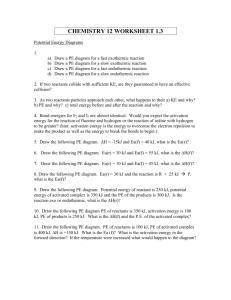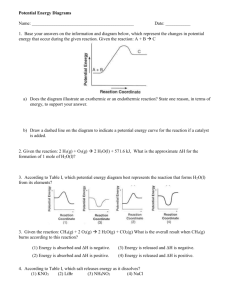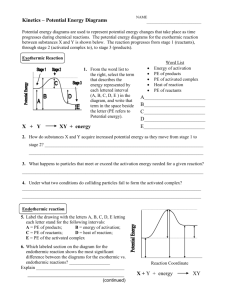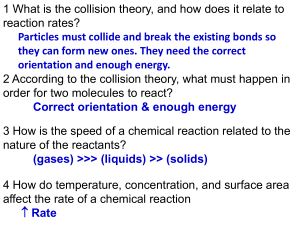Name Date Mrs. Jiménez
advertisement
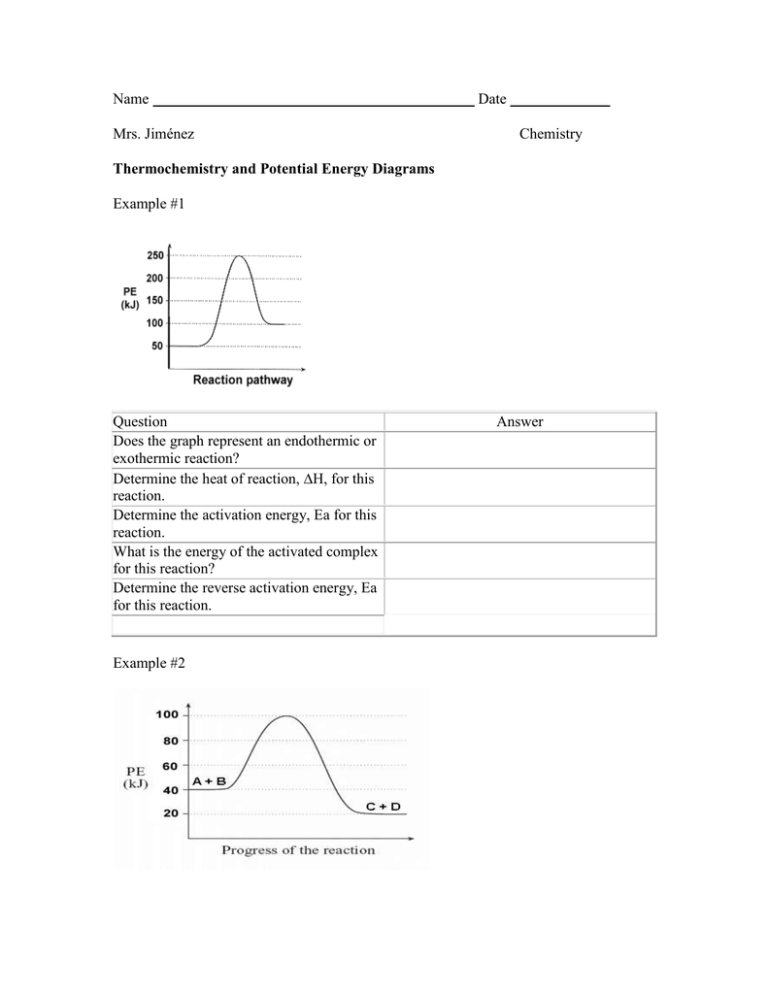
Name Mrs. Jiménez Date Chemistry Thermochemistry and Potential Energy Diagrams Example #1 Question Does the graph represent an endothermic or exothermic reaction? Determine the heat of reaction, H, for this reaction. Determine the activation energy, Ea for this reaction. What is the energy of the activated complex for this reaction? Determine the reverse activation energy, Ea for this reaction. Example #2 Answer Question Does the graph represent an endothermic or exothermic reaction? Determine the heat of reaction, H, for this reaction. Determine the activation energy, Ea for this reaction. What is the energy of the activated complex for this reaction? Determine the reverse activation energy, Ea for this reaction. Answer 3) Given the reaction: A + B --> C Does the diagram illustrate an exothermic or an endothermic reaction? State one reason, in terms of energy, to support your answer. 4) Given the reaction: 2 H2(g) + O2(g) --> 2 H2O(l) + 571.6 kJ What is the approximate ΔH for the formation of 1 mole of H2O(l)? (1) -285.8 kJ (2) +285.8 kJ (3) -571.6 kJ (4) +571.6 kJ 5) According to Table I, which potential energy diagram best represents the reaction that forms H2O(l) from its elements? 6) Given the reaction: CH4(g) + 2 O2(g) --> 2 H2O(l) + CO2(g) What is the overall result when CH4(g) burns according to this reaction? (1) Energy is absorbed and ΔH is negative. (3) Energy is released and ΔH is negative. (2) Energy is absorbed and ΔH is positive. (4) Energy is released and ΔH is positive. 7) According to Table I, which salt releases energy as it dissolves? (1) KNO3 LiBr (3) NH4NO3 (4) NaCl (2) 8) Given the reaction: S(s) + O2(g) à SO2(g) + energy Which diagram best represents the potential energy changes for this reaction? 9) Which statement correctly describes an endothermic chemical reaction? (1) The products have higher potential energy than the reactants, and the ΔH is negative. (2) The products have higher potential energy than the reactants, and the ΔH is positive. (3) The products have lower potential energy than the reactants, and the ΔH is negative. (4) The products have lower potential energy than the reactants, and the ΔH is positive. 10) A catalyst is added to a system at equilibrium. If the temperature stays constant, the activation energy of the forward reaction (1) decreases (2) increases (3) remains the same 11) The potential energy diagram below represents a reaction. Which arrow represents the activation energy of the forward reaction? (1) A (2) B (3) C (4) D 13) Explain how a catalyst may increase the rate of a chemical reaction. 14) Sketch the potential energy diagram for an endothermic chemical reaction that shows the activation energy and the potential energy of the reactants and the potential energy of the products. Base your answers to questions 15 through 16 on the information and potential energy diagram below. Chemical cold packs are often used to reduce swelling after an athletic injury. The diagram represents the potential energy changes when a cold pack is activated. 15) Which lettered interval on the diagram represents the potential energy of the products? 16) Which lettered interval on the diagram represents the heat of reaction? 17) Identify a reactant listed in Reference Table I that could be mixed with water for use in a chemical cold pack. 18) Which information about a chemical reaction is provided by a potential energy diagram? (1) the oxidation states of the reactants and products (2) the average kinetic energy of the reactants and products (3) the change in solubility of the reacting substances (4) the energy released or absorbed during the reaction 19) In a chemical reaction, the difference between the potential energy of the products and the potential energy of the reactants is defined as the (1) activation energy (2) ionization energy (3) heat of reaction (4) heat of vaporization 20) Given the balanced equation: 21) Given the potential energy diagram for a chemical reaction: Which statement correctly describes the energy changes that occur in the forward reaction? (1) The activation energy is 10. kJ and the reaction is endothermic. (2) The activation energy is 10. kJ and the reaction is exothermic. (3) The activation energy is 50. kJ and the reaction is endothermic. (4) The activation energy is 50. kJ and the reaction is exothermic. 22) Which expression represents the ΔH for a chemical reaction in terms of the potential energy, PE, of its products and reactants? (1) PE of products + PE of reactants (2) PE of products – PE of reactants (3) PE of products × PE of reactants (4) PE of products ÷ PE of reactants 23) Which balanced equation represents an endothermic reaction?
